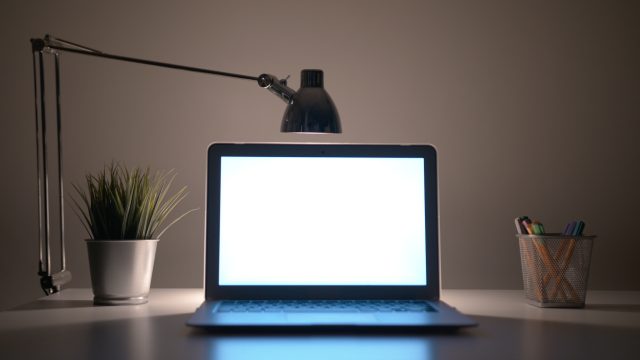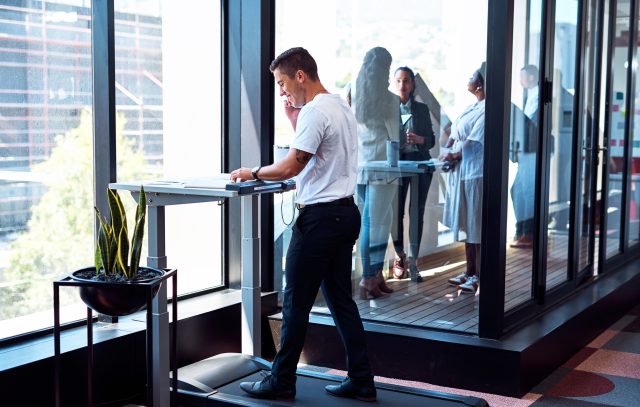With offices shuttered around the world, many people are experiencing working from home for the first time—or experiencing it in much longer doses than they were used to. Many companies are planning to keep employees working remotely at least part of the time well into 2021. And some are considering making it permanent.
Countless people have had to improvise their work-at-home workspaces. But now that we're several months in, some of that improvisation may be wearing thin. And one of the things that often gets pushed to the back burner in all this improvisation is ergonomics. If you haven't worked from home regularly in the past, and you're now sitting at the kitchen table every day working from a corporate-issued laptop, you're probably feeling the physical strains of this never-going-to-be-normal reality.
As someone who has worked primarily from home for a quarter of a century, I've had a lot of time to figure out what does and does not work in a home office. The changes that have come with COVID-19—including having my wife and daughter in lockdown with me, both working from home themselves—have required some adjustments and some re-equipping. We needed our home workspaces to support the new world of work while maintaining comfort and a reasonable level of sanity mid-pandemic.
These are not ideal times to begin with, but its still important to pay attention to the ergonomics of your home workspace. The last thing you want to do is add more stress (and potential repetitive stress injury) to life right now. That may mean acquiring a few new things to furnish your workspace, or improvising with what you have to make working from home more sustainable (or at least less of an OSHA violation).
Lighting
Not everyone can afford a dedicated space in their home for work. But it helps to pick someplace in your home that is specifically a workspace and to make sure it meets some basic needs. Make sure youve got even lighting to reduce eye strain, especially as you move your eyes from the computer monitor to elsewhere. If youre in a room where theres no overhead lighting, it's crucial to add some task lighting near your desk—especially behind your laptop screen.

The generally accepted standard for office lighting is 500 lumens per square meter (lux), or just over 45 foot-candles. OSHAs minimum allowable lighting for indoor offices is 30 foot-candles (322 lux). Given that a 60-watt bulb produces about 800 lumens, if youve got a 120 square foot (11 square meter) office, you would need five evenly spaced 60-watt bulbs (generating 4,000 lumens) just to meet OSHAs minimum.
When I re-outfitted my home office, I put in LED ceiling lighting that does a good job illuminating my workspace with help from natural light from windows. But we needed to get some task lighting for my wifes workspace once she started spending the whole day there. Task lighting was the quickest and most economical option—a floor lamp with directional lighting, using a bright LED bulb (in combination with some new bulbs for existing lights), brought the light around her workspace out of the dark ages. Desk lamps can be good, but it depends how much desk space you want to give up to lighting.

The lighting you choose will depend greatly on what makes you feel more productive and relaxed. While Ive gone for daylight white, you may prefer something warmer. I have an aversion to Internet of Things lightbulbs for various reasons, but one of their advantages is that many (including Wyze and Philips Hue) are tunable to a wide range of color temperatures. I have Philips Hue lights set up so that I can change the temperature of lighting depending on time of day and task.
The desk and chair (or not chair)
The couch does not make a good office. Regardless of what they call it, a “laptop” does not belong on your lap for very long. No, youre not going to (necessarily) go infertile, and theres no evidence to suggest that Wi-Fi is going to give you leg cancer. Its more about posture and repetitive stress—your neck and wrists are at greater risk than your genitals. Even those laptop “desks” designed for use while sitting on the couch or elsewhere do not correct enough for the posture horrors created by working on a piece of furniture designed for relaxation.
The same goes for working from the dining room table for a prolonged period of time: that chair and that table are not designed for hours of typing. While I was waiting for the paint to dry in my office, I worked from the dining room for a day—and it was less than optimal.

Its not necessarily the table thats the problem. Its the chair, along with the relative height of the table. The Mayo Clinics recommendations on ergonomics are for a work surface that is at or below elbow height, with a screen thats an arms length away—and viewed at a slight downward angle. If youre sitting, the Mayo Clinic says your knees should be about level with your hips, so there should be adequate clearance under the desk for knees, thighs and feet. Youll also need good enough lumbar support to make sure youre sitting at about a 90-degree angle to your hips, not hunched forward or leaning back.
I say “if youre sitting” because I gave up on office chairs a long time ago and moved to a full-time standing desk. After my Aeron chair my employers bought for my first full-time home office gig in 1995 reached the end of its useful life, I was reluctant to shell out that kind of money on my own for a new chair—particularly on a journalists budget. But I found that cheaper office chairs didnt offer enough lumbar support, and those options didnt fit in well with my multi-monitor, multi-keyboard work style. And ultimately, I found that if I saw sitting all day, I just wasnt moving around enough.
Because of my height, I found most convertible desks (including the electrically powered ones that rise to standing height with a push of a button) were not tall enough to comfortably type at, and I was leery about them supporting my array of monitors. I eventually bought a Husky workbench and an adjustable drafting chair for occasional resting periods. (Standing all day is not a great ergonomic choice, either.)

When my wife started working from home, I convinced her that having a choice about standing was a good idea. So I got her a Flexispot Laptop desk riser to go on top of her desk with adjustable-length legs. Then I purchased balance boards for both of us to add some additional motion into the day.
As far as office chairs go, you should go for support and comfort. If youre thinking long-term, prepare to pay for it: Herman Miller and Steelcase ergonomic chairs are comfortable, sturdy, made for heavy use, and cost over $1,000. The WorkPro 12000 Series offers many of the advantages of the Aeron—a breathable back, and good lumbar support—for under $500.
If you see yourself going back to an office commute when all this is over, though, you may consider a combo office/gaming chair—something like GTP Offices gaming chair, for example. That's a good dual-use chair for hours of either kind of screen time, and it has a lumbar massage feature that could come in handy with all the non-work stress were experiencing.
Input and output
The standard corporate-issue laptop may be de rigueur, but its far from ergonomic. Very few laptop keyboards are designed for all-day-every-day use, and laptop screens aren't large enough for full-time work usage. And the trackpad—well, most OEMs' trackpads (along with their appalling drivers and software) are about as anti-ergonomic as you can get, right?
People have very particular preferences about their input devices that often fly in the face of any sort of ergonomics. According to the experts, most keyboard, mouse, and monitor ergonomic recommendations are about good posture. Where you put your keyboard and pointing device (next to each other, with room to rest your arms) is probably more important than which devices you use. Keeping forearms straight while typing and not flaring the wrists upward helps a lot, so wrist rests can help level the playing field a bit. And having room to move the mice around without reaching over the keyboard or making awkward movements (if you're using a mouse) is equally important.


arstechnica
[contfnewc] [contfnewc]





